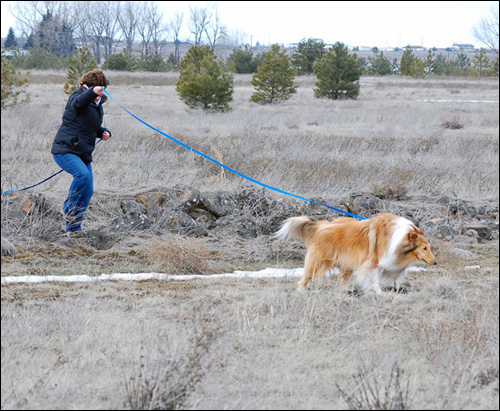|
by Suzanne Schwab
Even among dog-nerds, I often find it challenging to explain the appeal of training a dog to track. In 2009 for example, there were over 1.3 million entries in AKC conformation events, nearly 800,000 agility entries, over 13,000 herding entries, and not quite 2,000 tracking entries. In a typical year, perhaps five Collies will earn AKC tracking titles, compared to over 300 conformation championships. It’s a pity, because those folks who are spending Saturday mornings sleeping in, instead of wandering around some soggy field in the drizzling rain, are missing some of the most satisfying experiences one can have training a dog.
So, why should someone forgo the obvious pleasure of a nice cozy warm bed for an early morning excursion out into the field? For me, tracking is rivaled only by herding as a way to work in true partnership with my Collie friends. Don’t get me wrong -- I thoroughly enjoy the precision and communication that is required to train a dog to be a successful and enthusiastic obedience competitor, and if I had the time, I’d probably love agility too. But in both those activities, the humans are calling the shots, and hopefully they are skilled enough as trainers to convince the dog that he loves to follow his directions. Tracking is fundamentally different, because it’s ultimately the dog who is going to tell the human where the track goes, and it is up to the human to “obey” the dog.
Wine connoisseurs and professional perfume sniffers will attest to the fact that one’s ability to detect and discriminate scent can be greatly enhanced with practice. So, part of training the tracking dog does involve setting up increasingly difficult scenting challenges that actually do improve upon the dog’s innate ability to detect and follow a scent trail. But dogs come out of the birth canal basically knowing how to follow scent. It is we, the “trainers,” who are essentially clueless about scent. So most of tracking training really involves communicating to the dog what it is we want him to do, and then motivating the dog to follow the scent we designate rather than us training the dog how to track. The dogs are the experts at that skill, and once we’ve successfully communicated our goal, and motivated our dog to use his skills for our goals, we have to turn control over to the dog. It’s surprisingly difficult for many trainers to take that last step, and learn to accept that eventually their role is to be the follower, rather than the leader.
Tracking is fundamentally different, because it’s ultimately the dog who is going to tell the human where the track goes, and it is up to the human to “obey” the dog.
In conformation a savvy handler quickly sees whether the judge is going to ask for a “down and back” or a “triangle," the obedience competitor watches the heeling pattern, the agility handler walks the course until the sequence of obstacles is memorized . And then, when their turn comes, the handler directs the dog, and the dog follows the directions. At some point in training a tracking dog, the handler approaches a flag that marks the start of a track, has the dog sniff the article dropped by the tracklayer at that start point, and then makes a leap of faith. The handler has to obey the dog. The dog knows where the scent is and the handler doesn’t. Awesome is an overused word, but I can’t think of a better one to describe what it’s like to concentrate on nothing except what the dog is telling us, choose to obey the dog, and eventually find some crumpled up old sock or glove left several hours ago by a tracklayer out in the middle of some field hundreds of yards from the spot where we pointed to the ground, said “find it,” and made that leap of faith.

So, how does the handler communicate the goal and establish the motivation for a dog to follow a complicated track? There are dozens of nuances that can’t be covered in a single short article, but the basic principles are familiar to any good trainer. Start with ridiculously easy and highly rewarding tracks. In fact, what we start with barely seems like a track at all; it’s just a trail of yummy treats a few dozen feet long with a bonanza of treats on some article dropped at the end. Initially all the dog is doing is learning that sniffing the ground leads to delicious rewards, and that pulling out ahead of the handler leads to more and bigger rewards.
Gradually, very gradually, the track gets longer; the yummy treats are spaced farther apart, and eventually the track begins to bend and turn rather than always going straight ahead. The time between laying and running the track increases. Scenting challenges like changes in terrain and vegetation are added and roads, fences, rock outcrops, logs, and even streams are crossed. Other people walk over the track.
For the truly dedicated tracking team, tracks will be laid in urban settings along well-traveled sidewalks, across parking lots, and around a variety of buildings that cause scent to swirl and shift and do all sorts of confusing and challenging things. It’s a process that is very simple in concept, and infinitely challenging in actual practice. And it’s a process that is well worth sacrificing a morning of sleeping in, both because the training itself is so rewarding, and because afterwards you’ll know you’ve truly earned lunch followed by an afternoon nap snuggled up with your tired and happy tracking Collie. |